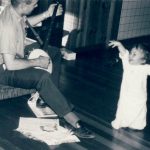 Life continued to revolve around family, road access, phone line, and having to earn a living—not always in that order. Having phone contact at the ranch was very important but getting to that point was taking a long time. There were trees to trim, insulators to put on them, brush to clear from underneath the line, wire to string, and Bob could work on it only after work or on weekends.
Life continued to revolve around family, road access, phone line, and having to earn a living—not always in that order. Having phone contact at the ranch was very important but getting to that point was taking a long time. There were trees to trim, insulators to put on them, brush to clear from underneath the line, wire to string, and Bob could work on it only after work or on weekends.
One Sunday, Bob went early to work on the phone line. Florence came to watch Rebecca while I went to join Bob. It was one of those warm spring days “with clouds frequently passing over the sun, making it cool enough for a sweater but as soon as the clouds passed, too warm for the sweater.”
Just before I’d left, Doris Ohde had phoned asking whether they could bring their lunch and eat at our house. I told her where we’d be and we met them as they drove up. We ate lunch above Waldens and then they walked up the trail and on up to the ranch. Bob and I worked till 4:00. I cut poison oak and other shrubs beneath the line and pruned the trail. We left a note asking Ohdes to dinner. They came and we had a very good time.
Bob met Scoot Miller on the way out and Scoot wanted to move our slides. Bob told him he hadn’t asked yet because we couldn’t pay him. He said he would do the work and we could pay when we had the money. The next day I had poison oak. Wednesday it was snowing.
My mother sent a letter about trapping pine martens. She and my dad had found old traps at the park where they were living–D.L. Bliss– (against the law in state parks). The season had been closed since 1952. The trappers would nail a piece of galvanized metal on the side of a tree and bend it into a little roof where they put the baited trap. When the season closed in 1952, pine marten pelts were worth $20-$40 each.
One day some boys from elementary school stopped by and I gave them all popsicles: Ricky, Lennie and Jim Anderson, Tony and Tye Duncan, and Kevin Monroe.
My morning walks were longer now and much easier as I started carrying Rebecca on my back in a Gerry Pack. These types of packs are common now for carrying children but were rare then. People used to stop me and marvel at what a great idea idea it was. One day, when walking with Rebecca, a deer came right up to us to be petted. The hair was worn off its neck where a collar had been—obviously had been someone’s pet.
Then my mother wrote that my dad had a heart attack two weeks ago. Why hadn’t they called one of my brothers or me? She drove him to a doctor and they did call a family friend who was a doctor. No heart damage but no more physical labor at that elevation. They didn’t want to be a bother to anyone but…yikes!
I substituted for a couple of days at Cox Bar School.
We continued to look for land where we could live while also trying to fix things up at the ranch and finally decided to buy land in Weaverville. I would have to go to work. We would rent the Ohde’s house for the coming school year as they were going to Corvallis so Dave could go to OSU during that time. I was offered a teaching job at the Weaverville elementary school.
Shooting stars, fawn lilies and redbud were in bloom at Big Flat as was buckbrush ceanothus. Madrones were just starting to bloom.
 In March Rebecca could take a couple of steps but by the end of April
In March Rebecca could take a couple of steps but by the end of April
she was running instead of walking, and preferably while holding something in one hand. She chattered constantly in her own language.

On the last day of April, after dinner, we drove downriver to look at a second proposed dam site for the Helena Dam. If used, all of Big Bar would be covered and the lake would be only a short distance from the ranch. Helicopter sites had to be prepared on both sides of the river, at both sites, so they could drill down about 200 feet. These had to be prepared by hand as it was too steep for bulldozers. We drove up Swede Creek to get a closer look at the spot.
This was part of a plan to send more water to Southern California from the northern part of the state. This State Water Plan would create a project that would include 10 dams and reservoirs, 700 miles of canals and pipelines, and eight hydroelectric power plants to send water from Northern California to cities and farms in central and southern California. A second plan, from what I could find online, was to bring even more water from places like the Trinity, where “water was abundant and people were not”. Part of the plan included a dam on the Eel River that would have flooded Round Valley near Covelo. But the dams, tunnels and pumps would have destroyed the salmon-fishing industry. My information source says that then Governor Ronald Regan refused to approve this plan.
I do have some concerns that such a plan might get resurrected, given the water needs, or perceived needs, of the state and the realization that climate change is affecting water supplies for cities and the huge agri-business industry.

